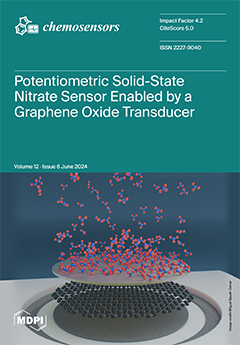Dopamine (DA) is an important catecholamine neurotransmitter in the mammalian central nervous system that affects many physiological functions. Hence, a highly sensitive and selective sensing platform is necessary for quantification of DA in the human body. In this study, ternary transition metal tellurides of CoNiTe
2 were successfully synthesized using the hydrothermal method. The proposed CoNiTe
2 nanomaterials were dispersed well in Nafion to form a well-dispersed suspension and, when dropped on a glassy carbon electrode (GCE) as the working electrode (CoNiTe
2/Nafion/GCE) for electrochemical non-enzymatic DA sensing, displayed excellent electrocatalytic activity for dopamine electrooxidation. The morphology and physical/chemical properties of CoNiTe
2 nanomaterials were characterized using field emission scanning electron microscopy (FESEM), transmission electron microscopy (TEM), X-ray diffraction (XRD), and X-ray photoelectron spectroscopy (XPS). In order to obtain the best electrochemical response to DA from the fabricated CoNiTe
2/Nafion/GCE, the experimental conditions of electrochemical sensing, including the CoNiTe
2 loading amounts and pH values of the phosphate buffer solution (PBS), were explored to achieve the best electrochemical sensing performance. Under optimal conditions (2 mg of CoNiTe
2 and pH 6.0 of PBS), the fabricated CoNiTe
2/Nafion/GCE showed excellent electrocatalytic activity of DA electrooxidation. The CoNiTe
2/Nafion/GCE sensing platform demonstrated excellent electrochemical performance owing to the optimal structural and electronic characteristics originating from the synergistic interactions of bimetallic Co and Ni, the low electronegativity of Te atoms, and the unique morphology of the CoNiTe
2 nanorod. It exhibited a wide linear range from 0.05 to 100 μM, a high sensitivity of 1.2880 µA µM
−1 cm
−2, and a low limit of detection of 0.0380 µM, as well as acceptable selectivity for DA sensing. Therefore, the proposed CoNiTe
2/Nafion/GCE could be considered a promising electrode material for electrochemical non-enzymatic DA sensing.
Full article





